Product overview
The liquid level gauge is used to measure and display the liquid level in the tank. There are many types of liquid level gauges. Commonly used liquid level gauges include: glass tube liquid level gauge, magnetic flap liquid level gauge, static pressure liquid level gauge, differential pressure liquid level gauge, float liquid level gauge, radar liquid level gauge, capacitance liquid level gauge, radio frequency admittance liquid level gauge, magnetostrictive liquid level gauge, servo liquid level gauge, etc.; those that measure the level include ultrasonic level gauge and radioactive level gauge, etc.
From the measurement principle, it can be divided into contact measurement, non-contact measurement, pressure principle measurement, etc. Below we introduce the working principles and applications of various liquid level meters one by one.
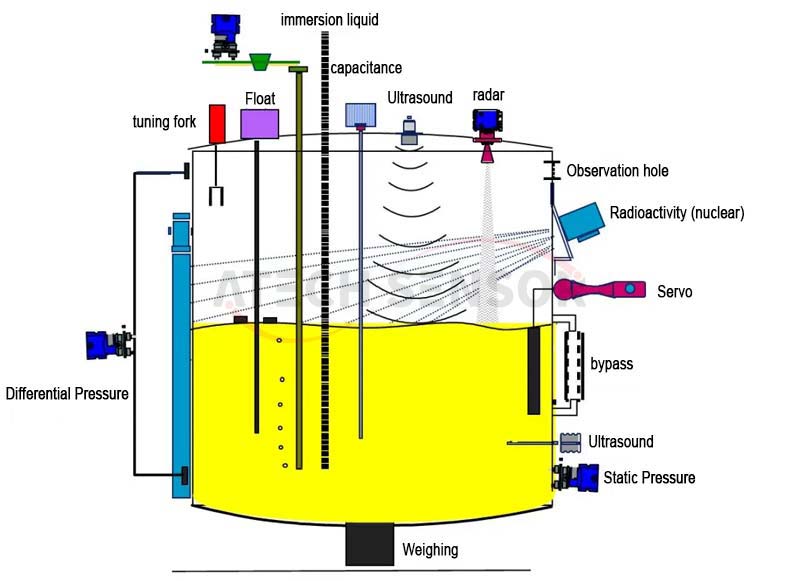
Working principle
1: Glass tube level gauge
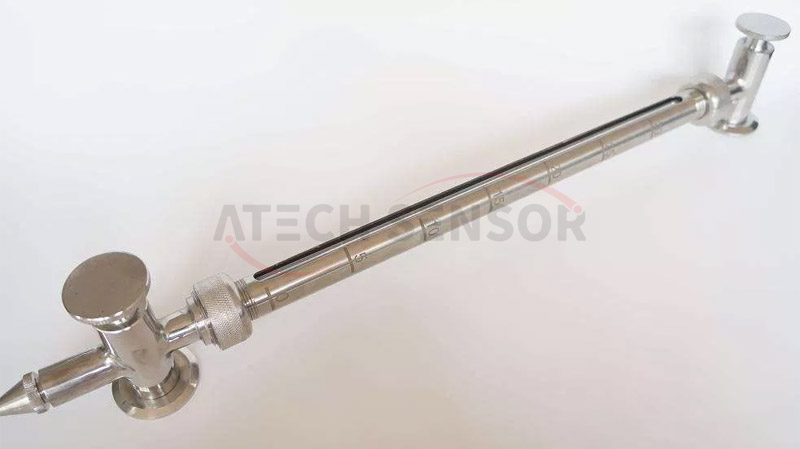
Principles:
The glass tube level gauge is designed based on the principle of communicating vessels. It consists of a glass tube and the main body of the level gauge. The liquid passage is connected to the container to be measured through a connecting flange or tapered pipe thread to form a communicating vessel. The liquid level observed through the glass tube is the same as the liquid level in the container, that is, the liquid level height.
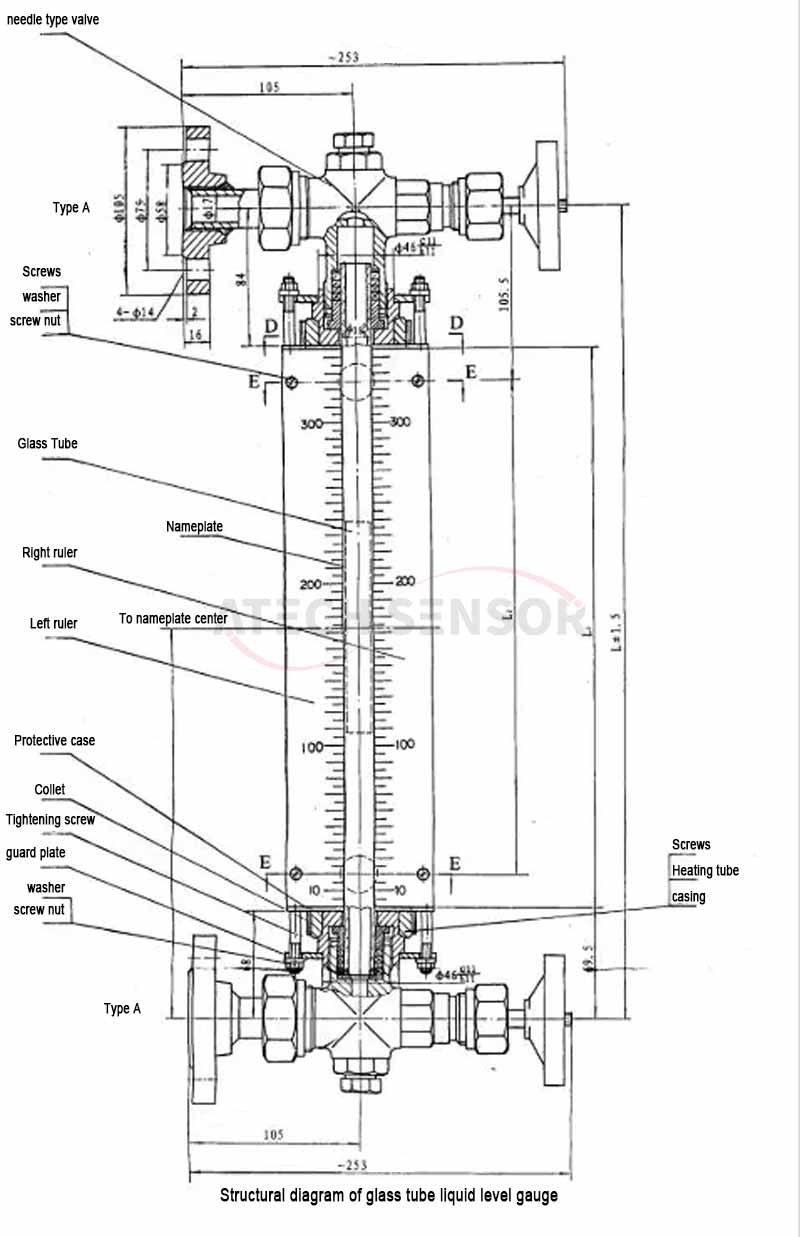
The needle valves at both ends of the level gauge produced according to the standard not only act as stop valves, but also the steel ball inside it functions as a check valve. When the level gauge is accidentally damaged or leaks, the steel ball can automatically close the liquid channel under the pressure of the medium to prevent a large amount of liquid from flowing out, which plays a safety protection role, provided that the pressure in the tank is greater than 0.2Mpa. The level gauge can achieve functions such as anti-corrosion, heat preservation, anti-frost, and lighting by changing the material of the parts or adding some auxiliary parts.
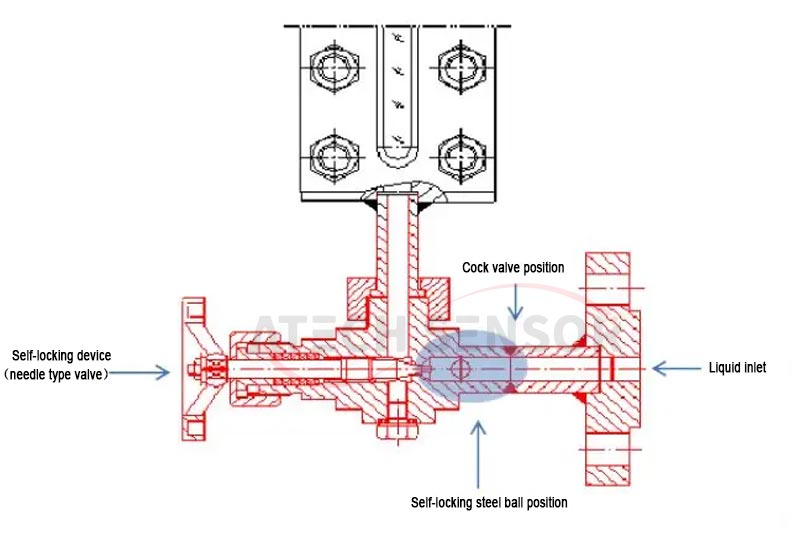
Because the glass tube is fragile, the glass tube level gauge is usually equipped with a sheath to protect the glass tube. Some level gauges also have a sampling valve for sampling the liquid in the tank or draining the liquid in the glass tube level gauge during maintenance.
It is generally recommended that the length of the glass tube level gauge should not exceed 2 meters. If you want to measure the liquid level higher than 2 meters, it is recommended to use a multi-stage staggered installation, as shown in the following figure:

Scope of application and features:
Glass tube level gauge has the advantages of simple structure, economical and practical, easy installation, reliable operation and long service life.
However, the disadvantages are also obvious: the inner surface is easy to be contaminated, which makes reading difficult and inconvenient for remote transmission and adjustment.
As a basic liquid level indicator, this product is widely used in the measurement and monitoring of liquid levels in the simplest liquid level measurement occasions and large-scale engineering projects with low automation.
The installation of the glass tube level gauge should follow the following steps:
(1) Before installing the level gauge, please carefully disassemble the box to avoid breaking the glass due to the nails on the box. Then do not hit the glass tube level gauge body too hard during installation. Do not have excessive vibration.
(2) After the level gauge is installed, when the medium temperature is very high, do not open the valve immediately. Preheat it for 20-30 minutes, and then slowly open the valve after the glass tube reaches a certain temperature.
Valve opening procedure: first slowly open the upper valve, then slowly open the lower valve, so that the measured medium slowly enters the glass tube.
(3) When using the liquid level meter, the dirt on the inner and outer walls of the glass tube should be cleaned regularly to keep the liquid level display clear. Cleaning procedure: First close the upper and lower valves connected to the container, open the drain valve, drain the residual liquid in the glass tube, use appropriate cleaning agents or use a long-handled brush to remove dirt on the inner wall of the tube.
2: Magnetic flap level gauge
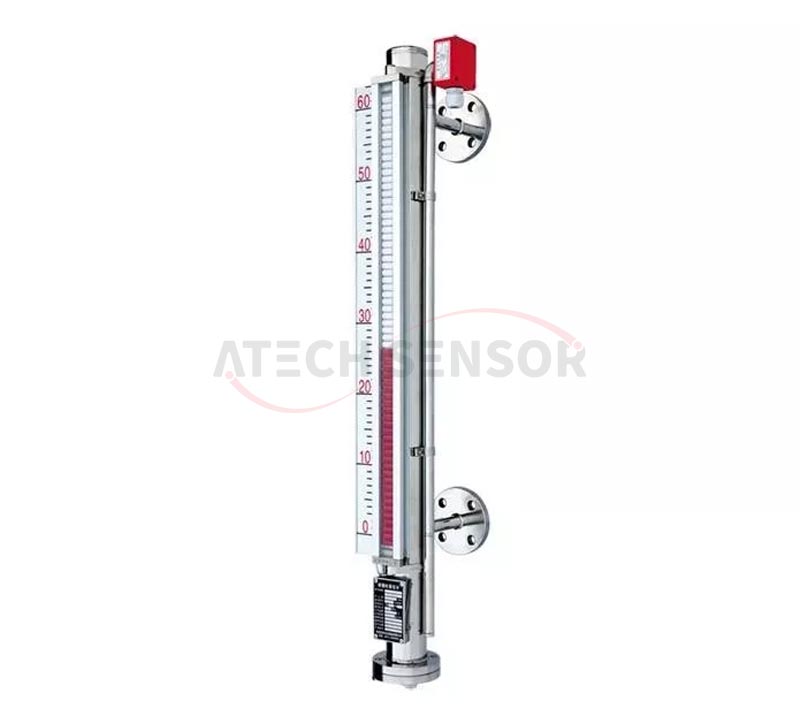
principle:
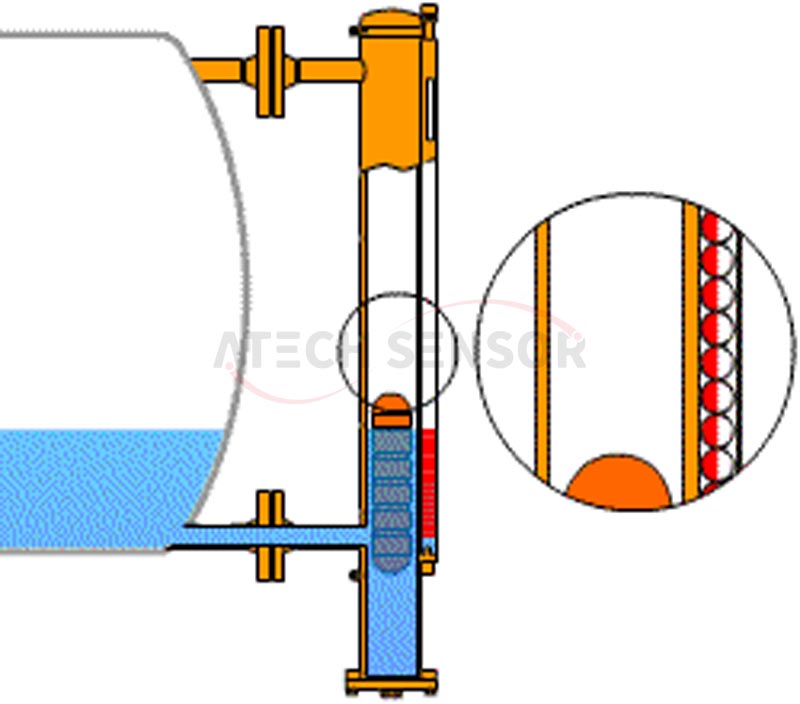
It works according to the principle of buoyancy and magnetic coupling. When the liquid level in the measured container rises or falls, the float in the main pipe of the magnetic flap level gauge also rises or falls. The permanent magnet in the float is transmitted to the on-site indicator through magnetic coupling, driving the red and white flip columns to flip 180°. When the liquid level rises, the flip column turns from white to red, and when the liquid level drops, the flip column turns from red to white. The red and white boundary position of the indicator is the actual height of the medium level in the container, thereby realizing the indication of the liquid level.
It can be displayed locally and controlled remotely. When used for remote control, the magnet in the float and the sensor (reed switch) act to change the number of components (such as fixed value resistors) connected in series in the circuit, thereby changing the electrical quantity of the instrument circuit system. That is, the change in the position of the magnetic float causes the change in the electrical quantity.
By detecting the change of electrical quantity, the liquid level in the container is reflected. It can directly output the resistance value signal, or it can be used with the transmitter module to output the current value (4-20mA) signal; at the same time, it can be used with other converters to output voltage signals or switch signals. Thus, the remote transmission, analysis and control of electrical signals can be realized.
The magnetic flap level gauge has the direct reading characteristic of on-site display. It does not require multiple groups of level gauges.
Due to the closed structure of magnetic coupling isolator, it is especially suitable for the detection of flammable, explosive, corrosive and toxic liquid levels, making the liquid level detection method in the original complex environment simple, reliable and safe.
Depending on the installation position, there are side-mounted magnetic flap level gauges and top-mounted level gauges.
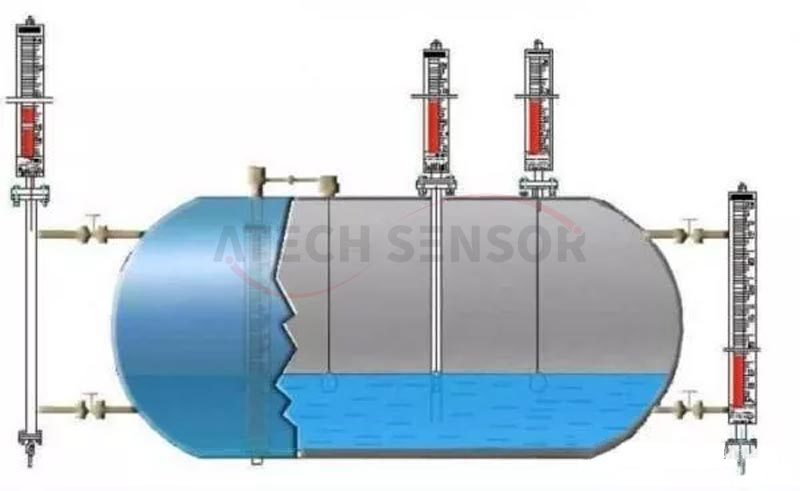
Scope of application:
Widely used in liquid level measurement, control and monitoring in the fields of petroleum processing, food processing, chemical industry, activated carbon dosing device, lime dosing system, potassium permanganate dosing equipment, dosing equipment, pharmaceutical, electric power, papermaking, metallurgy, shipbuilding and boilers.
Advantages: Magnetic float level gauge can achieve high sealing, anti-leakage and is suitable for high temperature, high pressure and corrosion resistant occasions. It is more superior for high temperature, high pressure, toxic, harmful and highly corrosive media.
Disadvantages: The magnetic float is in direct contact with the medium, the float ball sealing requirements must be strict, and viscous media cannot be measured. If the magnetic material is demagnetized, it is easy to cause the level gauge to not work properly, and the flap is easy to get stuck, resulting in the inability to transmit the indication remotely.
3: Static pressure level gauge
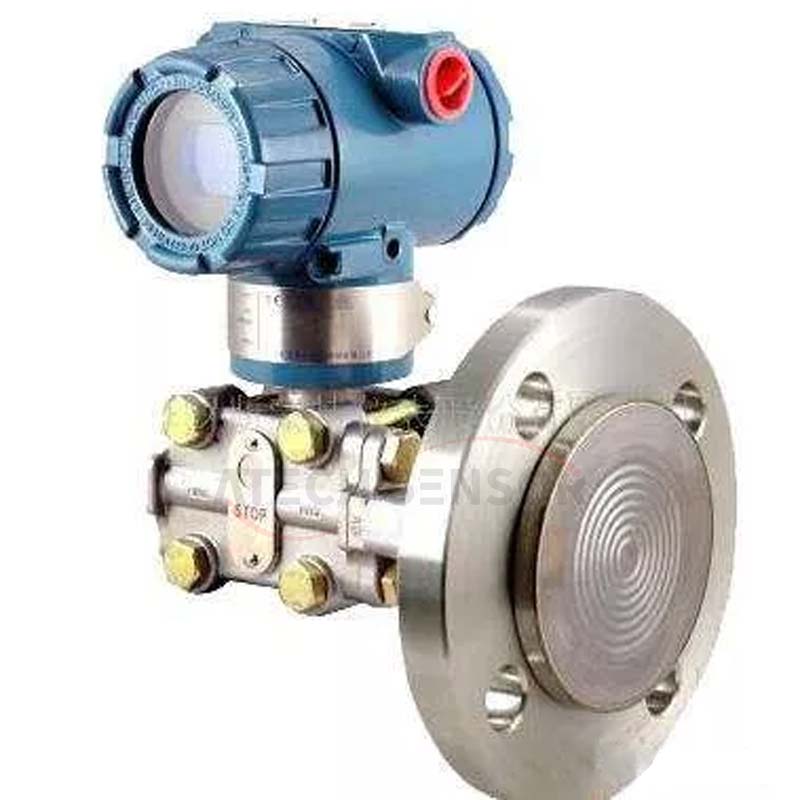
Principle:
When the pressure sensor penetrates or contacts the measured liquid, the medium pressure P it is subjected to is proportional to the height h of the liquid level of the measured liquid, and the linearity is very high:
That is: P=ρgh Where:
ρ: Density of the measured medium (kg/m3)
g: Local gravity acceleration (m/s2)
h: Height of the measured liquid (m)
For a certain measured medium and the same location, ρ and g are both constants. It is easy to get: h=P/(ρg)
The above expression is the core formula in the working principle of the liquid level transmitter.
The transmitter probe (with a sensor installed on it) installed at the bottom of the container detects the pressure proportional to the liquid level and converts it into an electrical signal, which is then transmitted to the conversion unit on the liquid storage container. The electrical signal related to the liquid level is converted into a 4~20mA standard signal and output.
Static pressure level gauges are available in bottom-mounted and immersion types.
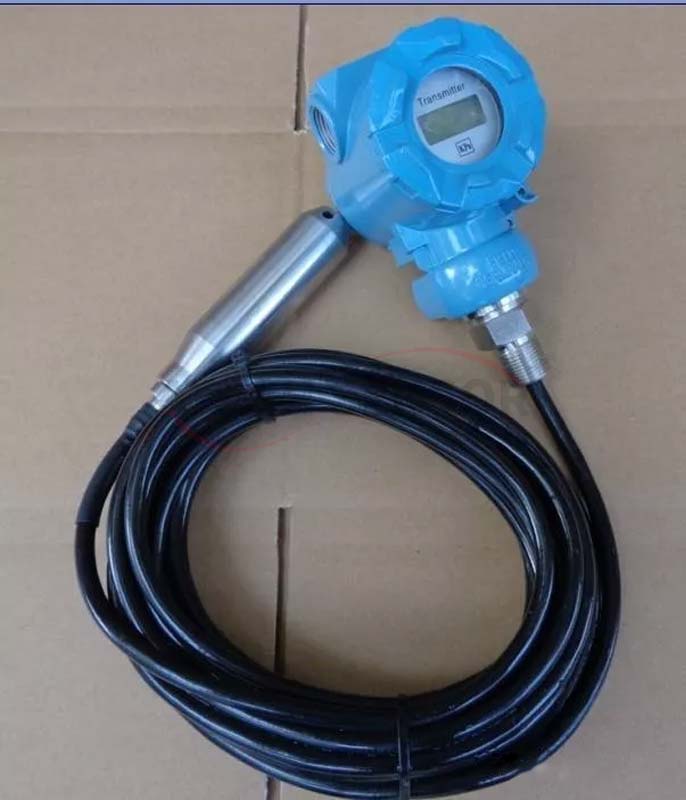
Static pressure level gauges are only used to measure the liquid level of tanks that are connected to the atmosphere. If there is pressure in the tank, a differential pressure level gauge should be used.
Advantages: Static pressure is proportional to liquid level, so the liquid level can be measured by measuring the static pressure of the liquid column on the reference surface using a pressure gauge. Widely used and easy to calibrate.
Disadvantages: Because it is greatly affected by the density and temperature of the medium, the accuracy is often poor. In order to eliminate these effects, many other test instruments are required. As a result, it is very expensive to build a complete static pressure measurement system.
4: Differential pressure level gauge
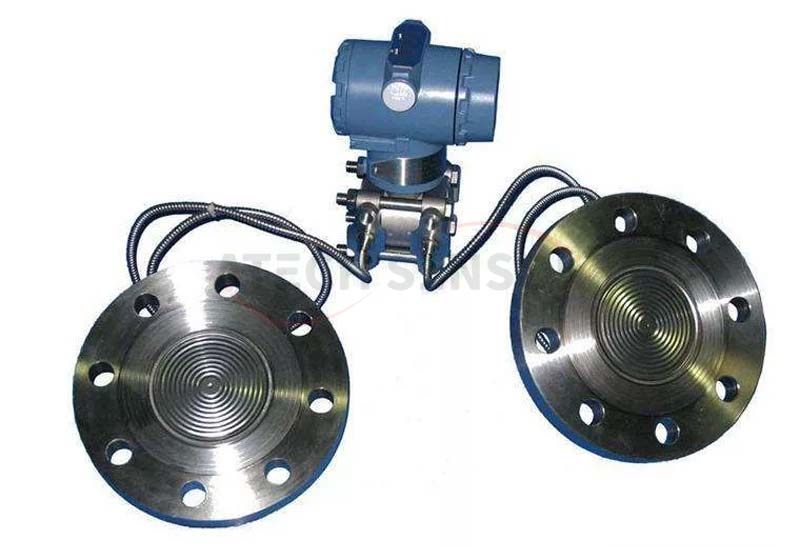
Principle:
The differential pressure level transmitter measures the difference between high and low pressures, and then converts it into a current signal by the conversion component and transmits it to the control room. The differential pressure level gauge is mainly used for level measurement of closed pressure vessels. The size of the differential pressure also represents the size of the liquid level height. The differential pressure gauge is used to measure the differential pressure value between the gas and liquid phases to know the liquid level.
When using a differential pressure transmitter to measure the liquid level, due to the different installation positions of the differential pressure transmitter, the positive and negative pressure pipes are filled with liquid, and these liquids will cause the differential pressure transmitter to have a fixed differential pressure. When the liquid level is zero, the differential pressure gauge indicates not at zero, but a positive or negative indication deviation.
In order to indicate correctly and eliminate this fixed deviation, it is necessary to move the zero point downward or upward, that is, to perform "zero point migration". This differential pressure value is called the migration amount. If this value is positive, the system is called positive migration; if it is negative, the system is negative migration; if this value is zero, there is no migration.
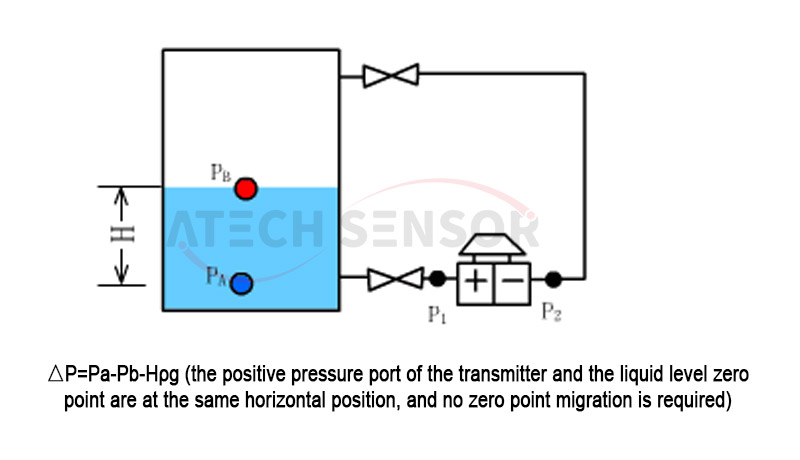
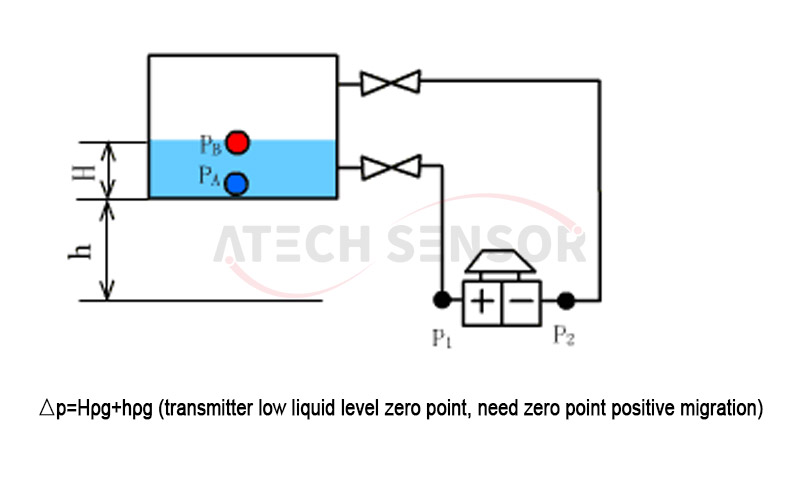
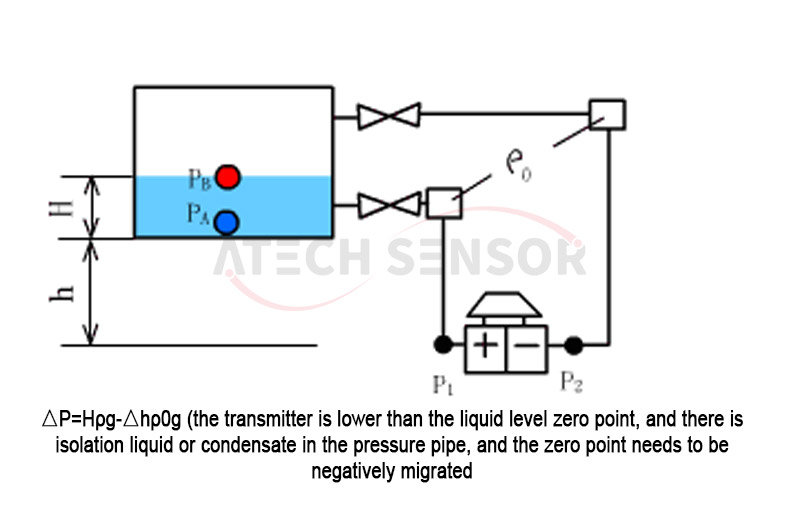
Application range:
This product has reliable performance and excellent measurement level. It is generally suitable for measuring water-based media, crude oil or other liquid levels. When using the immersion method to measure and control the liquid level, it is very convenient to use a liquid level transmitter with a standard output signal: it can be directly used with CNC instruments and is interchangeable.
Advantages and disadvantages are the same as those of static pressure level gauges
5: Float level gauge
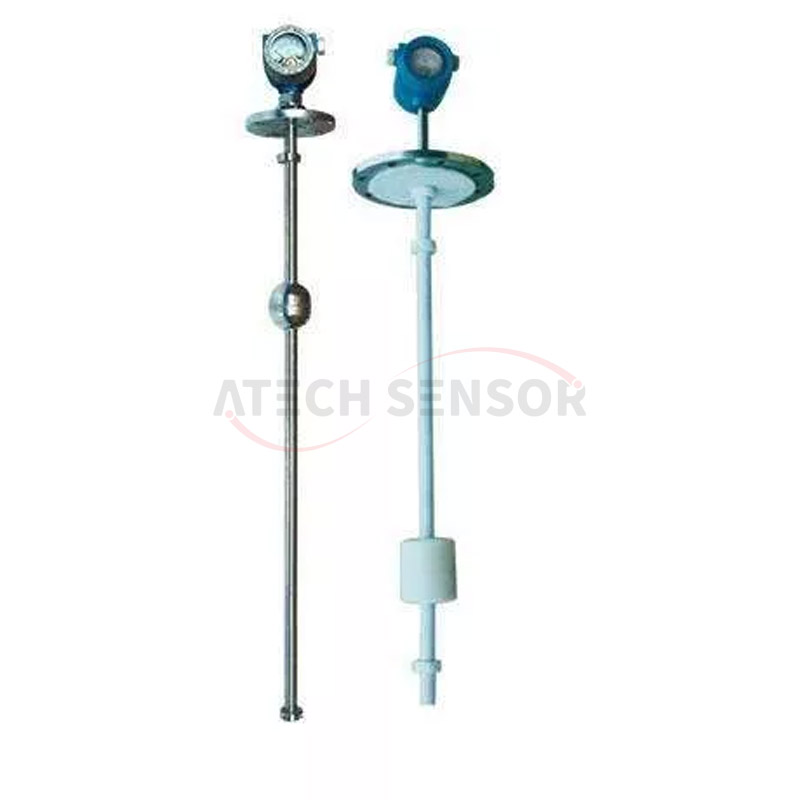
principle:
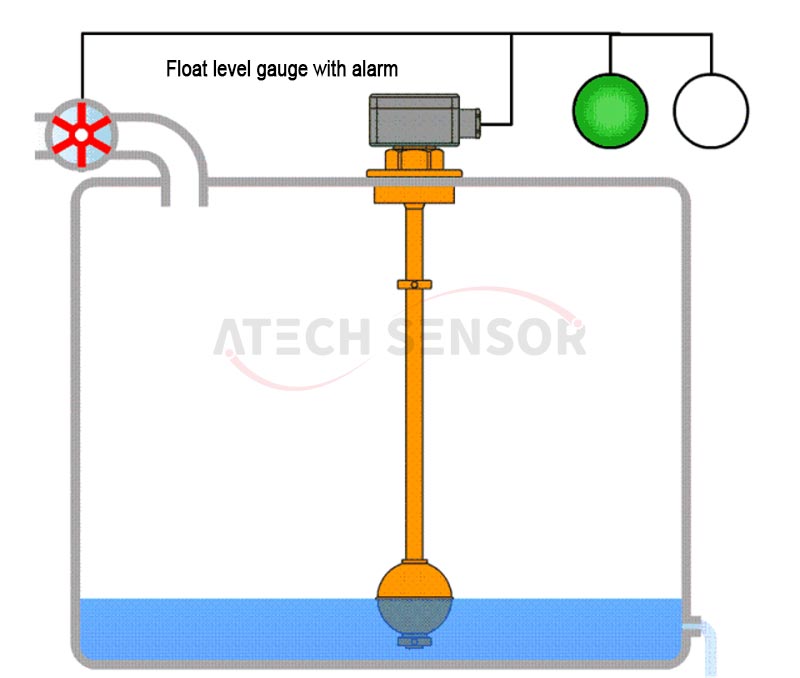
The structure of the float level meter is mainly designed and produced based on the principles of buoyancy and static magnetic field. The position of the float with a magnet (referred to as the float) in the measured medium is affected by the buoyancy: the change in the liquid level causes the change in the position of the magnetic float. The magnet and sensor (reed switch) in the float change the number of components (such as fixed resistors) connected in series in the circuit, thereby changing the electrical quantity of the instrument circuit system. That is, the change in the position of the magnetic float causes the change in the electrical quantity.
The liquid level in the container is reflected by detecting the change in the electrical quantity. The level meter can directly output the resistance value signal, or it can be used with a transmitter module to output the current value (4~20mA) signal; at the same time, it can be used with other converters to output voltage signals or switch signals. This enables remote transmission, analysis and control of electrical signals.
Note: The measured medium should not contain ferromagnetic impurities.
There are three installation methods for float level gauges:
1: Side bottom installation 2: Top installation 3: Side side installation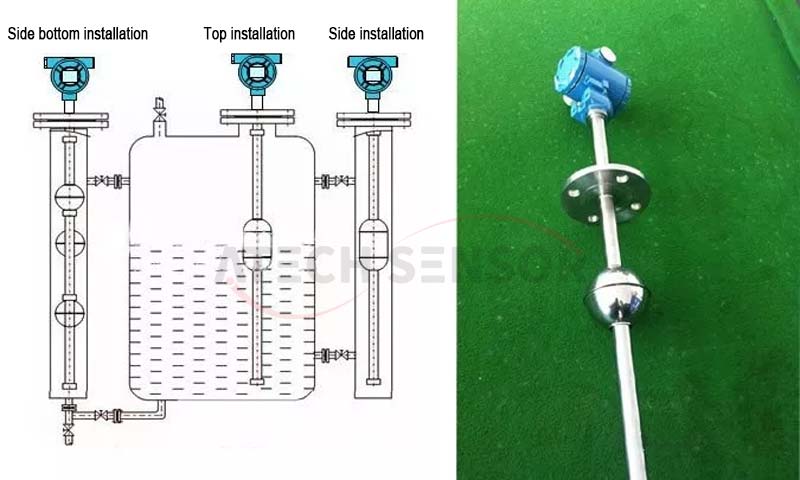
6: Radar level meter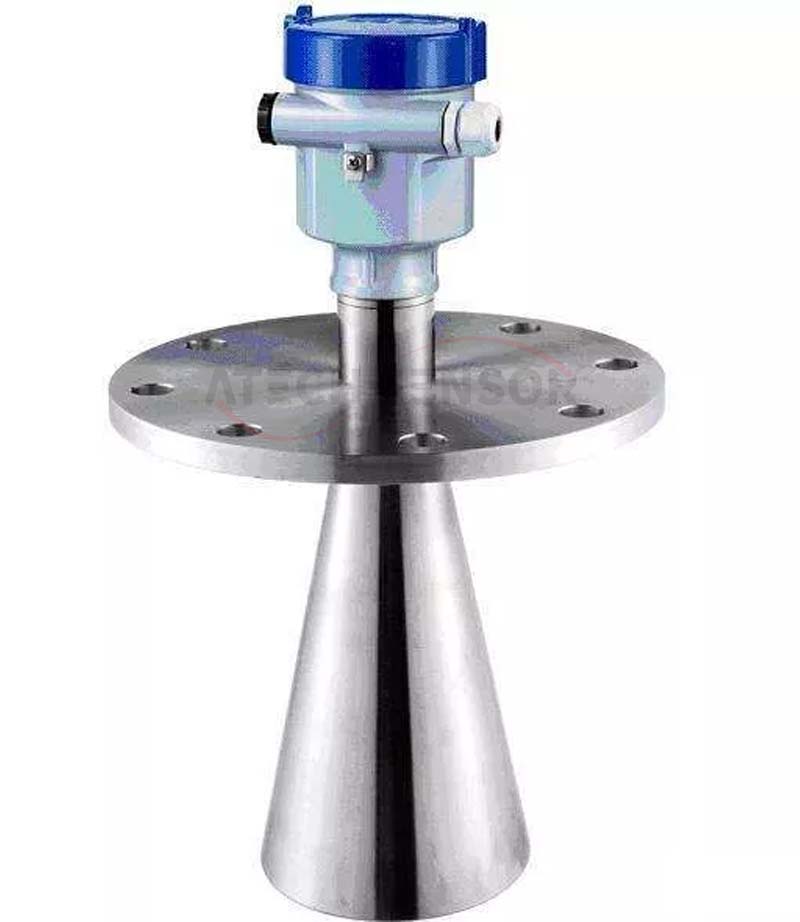
Principle:
Radar level meter is a microwave level meter based on the time travel principle. It is an application of microwave (radar) positioning technology. It transmits energy waves through a device that can transmit energy waves (generally pulse signals). The energy waves are reflected by obstacles and a receiving device receives the reflected signals. The level change is determined by measuring the time difference of the energy wave movement process. The microwave signal is processed by an electronic device and finally converted into an electrical signal related to the level.
In microwave level measurement equipment, the energy waves used are usually high-frequency electromagnetic waves with a frequency of 8.3GHz (mostly around 6GHz, and there are also higher frequencies). The energy waves used by this device are pulse energy waves. Generally, the maximum pulse energy of a pulse energy wave is about 1mW (the average power is about 1μW), which will not cause radiation damage to other equipment and personnel.
Scope of application and features:
The radar level meter is used for non-contact continuous measurement of the level of liquids, slurries and granular materials. It is suitable for occasions with large temperature and pressure changes and the presence of inert gas or steam. It uses the microwave pulse (PTOF) measurement method and can work normally within the industrial frequency band. The beam energy is low and can be installed in various metal or non-metal containers or pipes, without any harm to the human body or the environment.
Advantages:
1. No blind spots, high precision
2. No transmission medium is required, and it is not affected by pressure changes, vacuum, temperature changes, inert gas, smoke, steam and other environmental factors. It can be used to measure volatile media.
3. The output signal is 4mA~20mA/HART protocol, and the calibration is simple. The on-site calibration operation can be easily realized through the digital LCD display, and the simple configuration setting and programming can be realized through the software.
4. It can be used in high temperature conditions, up to 200℃ process temperature, and up to 350℃ when using high temperature extension antenna.
Disadvantages: Expensive, the instrument needs to set many parameters; the antenna will report an error if it is accidentally stained with the medium; the antenna needs to be cleaned if there is icing; the initial installation requires a tank without medium.
7: Capacitive liquid level gauge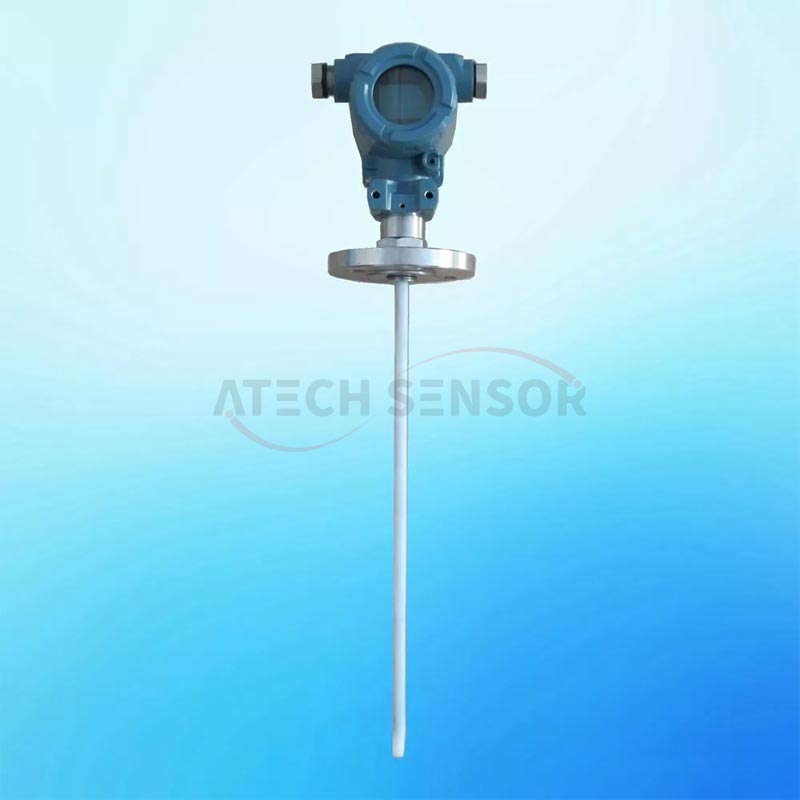
principle: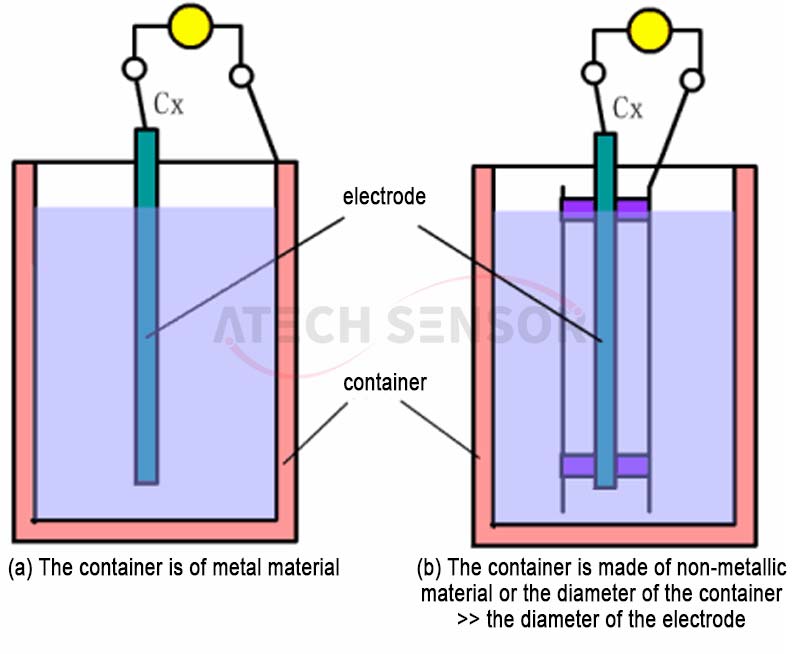
The measurement principle of the capacitive level meter is that the oscillation frequency of the oscillation circuit is related to the capacitance value. The change of the material level causes the change of the system capacitance, which in turn changes the oscillation frequency of the oscillation circuit. The oscillation circuit in the sensor can convert the change of capacitance caused by the change of the liquid level into a change of frequency, and send it to the electronic module. After the calculation and analysis, it is converted into an engineering quantity for display, thereby realizing the continuous measurement of the liquid level.
It consists of a sensor, a secondary instrument and other accessories. The sensor is placed on the top of the tank, the probe is vertically extended into the tank, and the secondary instrument is placed in other suitable places. The sensor converts the change of the liquid level into a corresponding electrical pulse signal, which is transmitted to the secondary instrument for processing and displaying the liquid level height, and has a high/low limit alarm and a 4~20mA transmission output. It is suitable for liquid/solid material crop level display, alarm, control and remote transmission display or composition system.
Scope of application and features:
Advantages: simple structure, easy installation, reliable performance; the electrode is made of stainless steel, has strong corrosion resistance, can be used with both insulating and conductive materials, and requires little maintenance.
Disadvantages: The dielectric constant needs to be stable, otherwise there will be a large error. It is not suitable for occasions where the dielectric constant or material humidity changes too much and solid media where the material particles are larger than 15mm and cannot be in good contact with the electrode.
The liquid level meter can be widely used in petroleum, chemical, electric power, metallurgy, food, environmental protection and other industrial sectors to monitor the material level in open or pressurized containers.
8: Radio frequency admittance level meter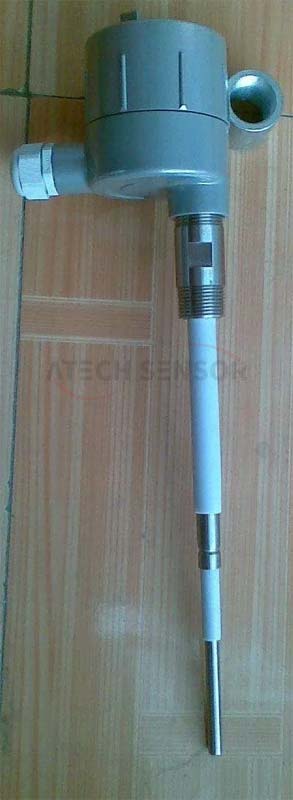
principle:
RF admittance is a new type of level control technology developed from capacitive type, which is more reliable, more accurate and more applicable. It is an upgrade of capacitive level technology. The so-called RF admittance means the reciprocal of impedance in electricity. It is composed of resistive components, capacitive components and inductive components. RF is a high-frequency radio spectrum, so RF admittance can be understood as measuring admittance with high-frequency radio waves.
When the instrument is working, the sensor of the instrument forms an admittance value with the wall and the measured medium. When the level changes, the admittance value changes accordingly. The circuit unit converts the measured admittance value into a level signal output to achieve level measurement. It makes the product anti-hanging (the material adhered to the sensor is called hanging) have better performance, more reliable operation, more accurate measurement and wider applicability.
It is mainly composed of sensor module, electronic module and some other connecting devices. The sensor unit mainly includes three parts: measuring probe, shielding electrode and grounding terminal. The height of the measured material is reflected as the change in admittance between the measuring probe and the container wall. When the material reaches the switch operating point, the electronic unit responds, drives the relay to operate, and outputs a switch signal.
The shielding electrode can prevent false operation signals due to material hanging on the electrode. The switch control signal is output only when the material actually reaches the set point.
Scope of application and features:
The microwave level controller adopts advanced radio frequency admittance technology, which overcomes the defect that the capacitive level switch cannot eliminate the influence of conductive hanging materials. It has the following features:
Strong versatility: Suitable for various occasions, can detect particles, fly ash, conductive, non-conductive liquids, viscous materials;
Anti-adhesion circuit: Advanced anti-adhesion circuit design can eliminate false error signals caused by material adhesion;
Power failure protection mode: low or high fault alarm. Adjustable on site.
Widely used for alarm and control of liquid, slurry, dust, material level and two liquid interface. Can add on-site working status indication, is a highly cost-effective, stable and reliable level switch.
9: Magnetostrictive level gauge
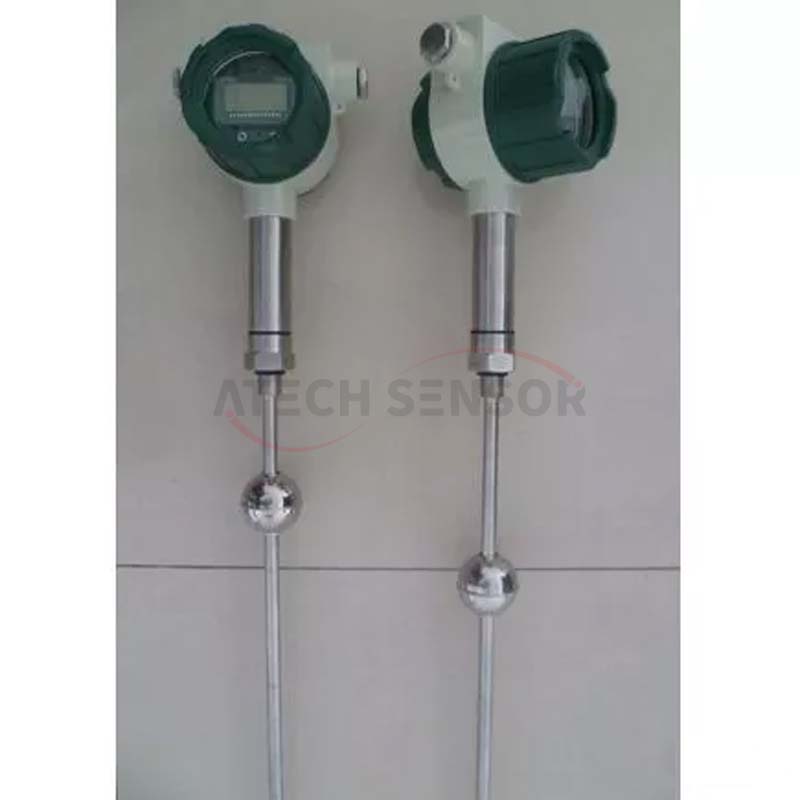
principle:
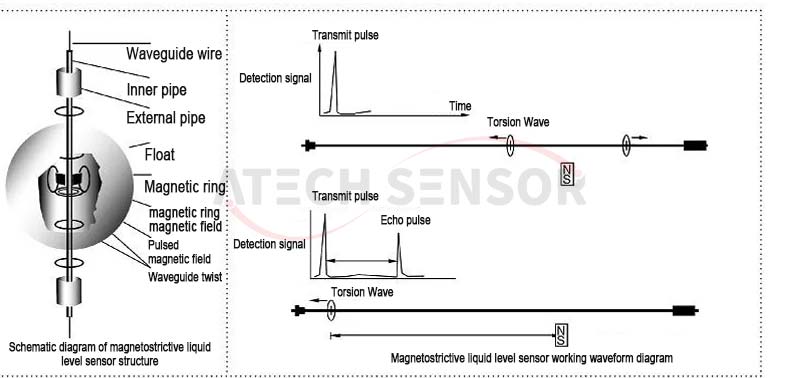
When the sensor of the magnetostrictive level gauge is working, the circuit part of the sensor will excite a pulse current on the waveguide wire, and when the current propagates along the waveguide wire, a pulse current magnetic field will be generated around the waveguide wire. A float is provided outside the sensor rod of the magnetostrictive level gauge, and the float can move up and down along the rod as the liquid level changes.
There is a set of permanent magnetic rings inside the float. When the pulse current magnetic field meets the magnetic ring magnetic field generated by the float, the magnetic field around the float changes, so that the waveguide wire made of magnetostrictive material generates a torsional wave pulse at the position of the float. This pulse is transmitted back along the waveguide wire at a fixed speed and detected by the detection mechanism. By measuring the time difference between the pulse current and the torsional wave, the position of the float, that is, the position of the liquid level, can be accurately determined.
Advantages: Magnetostrictive level gauges have high accuracy, are suitable for oily liquids, and can measure the oil-water interface.
Disadvantages: Magnetostrictive level gauges are not widely used in the market due to their contact measurement method and high installation and maintenance requirements.
10: Ultrasonic level meter
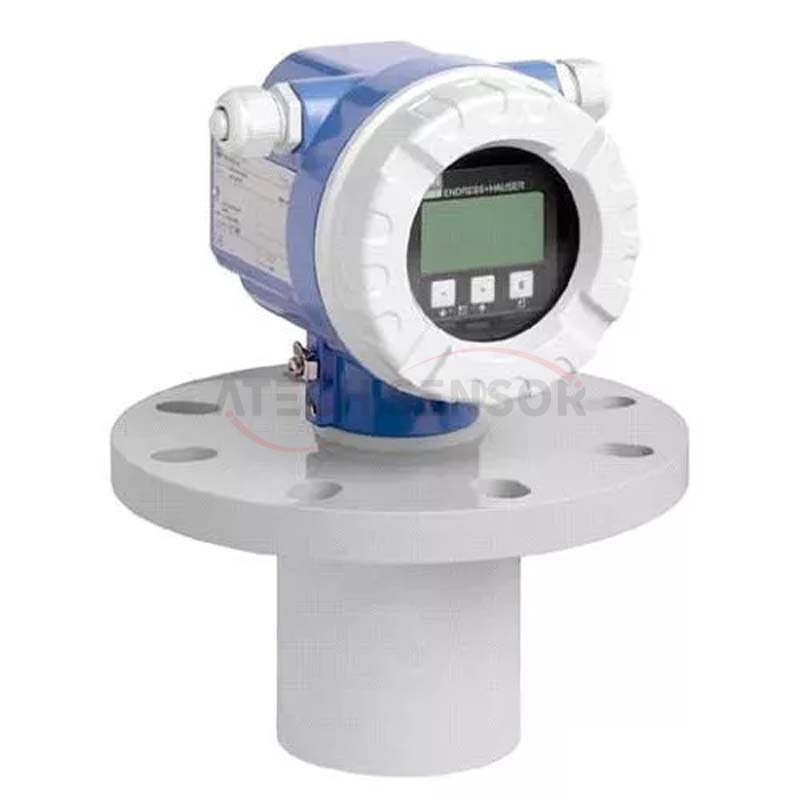
principle:
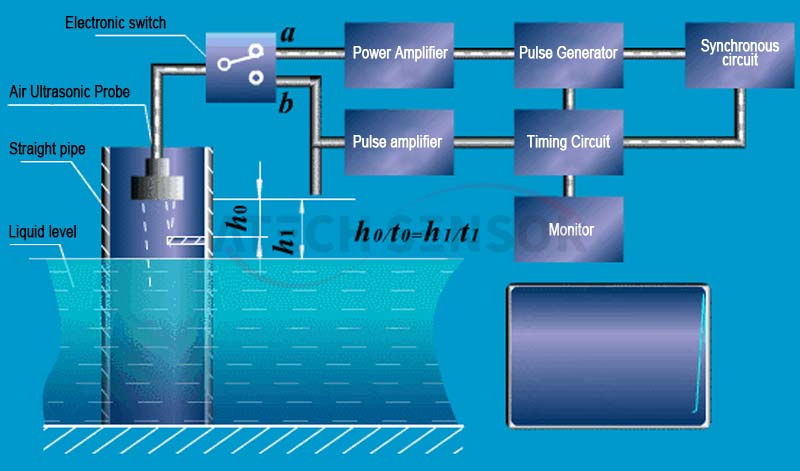
The ultrasonic level meter transmits energy waves through a device that can transmit energy waves (generally pulse signals). The energy waves are reflected by obstacles and a receiving device receives the reflected signals.
The level change is determined by measuring the time difference of the energy wave movement process. The microwave signal is processed by an electronic device and finally converted into an electrical signal related to the level. The probe transmits an ultrasonic pulse signal to the surface of the measured medium. The ultrasonic wave is reflected after encountering the measured medium (obstacle) during the transmission process. The reflected ultrasonic signal is detected by the electronic module and processed by special software. The time difference between the emission of the ultrasonic wave and the echo is analyzed. Combined with the propagation speed of the ultrasonic wave, the distance of the ultrasonic wave propagation can be accurately calculated, and then the level can be reflected.
The ultrasonic level meter is a sound wave and requires a transmission medium, so it will be affected by the temperature and pressure in the tank.
Advantages: No mechanical transmission part, high reliability, non-contact measurement, and not affected by liquid viscosity, density, etc.
Disadvantages: There is a blind spot in the measurement, it is not recommended to use when there is pressure in the tank, and volatile media cannot be measured.
11: Servo liquid level gauge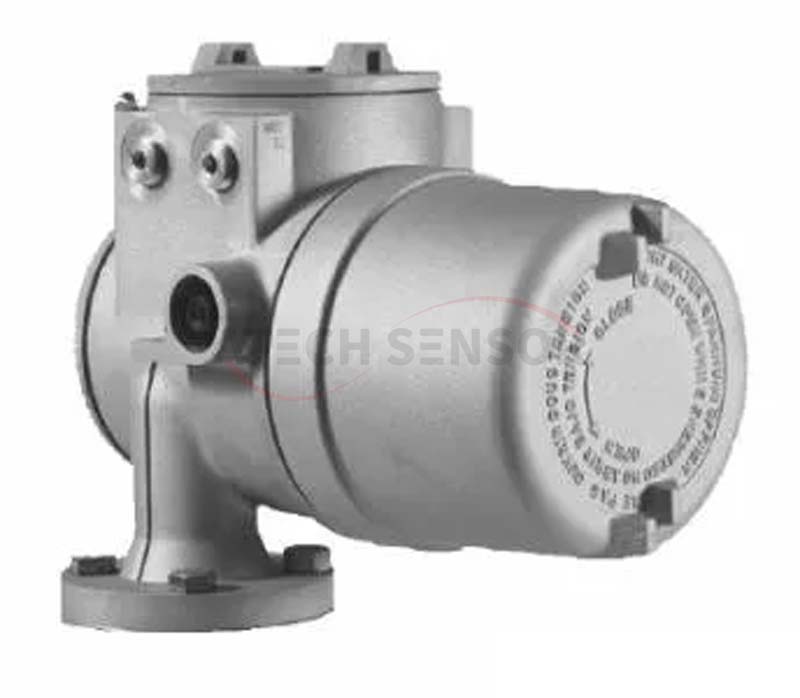
principle:
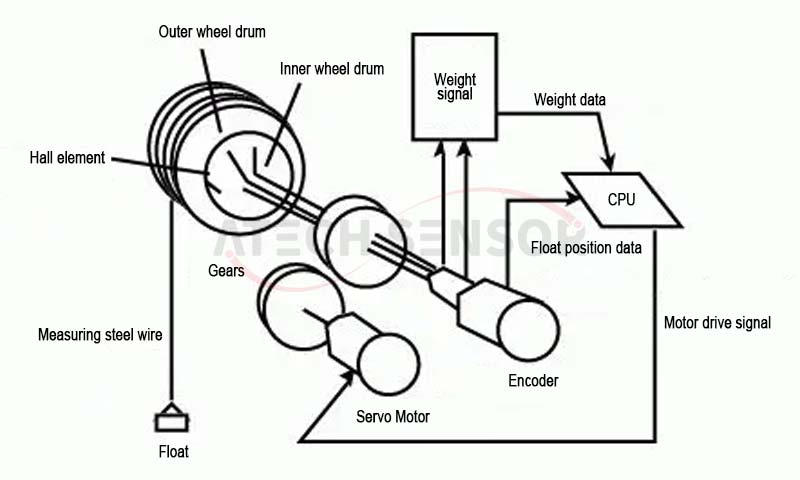
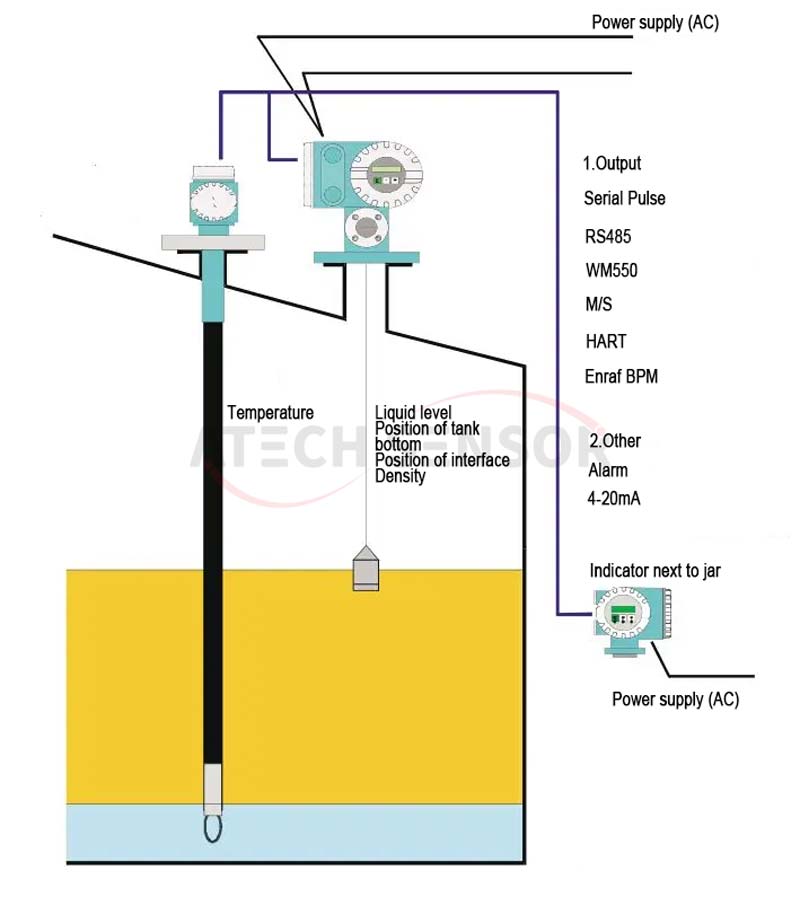
The servo level gauge is based on the principle of buoyancy balance. The micro servo motor drives a small float and can accurately measure parameters such as liquid level. When the level gauge is working, the gravity of the float acting on the thin steel wire generates a torque on the magnet of the outer drum, causing a change in magnetic flux.
The change in magnetic flux between the drum components causes the output voltage signal of the electromagnetic sensor (Hall element) on the inner magnet to change. Its voltage value is compared with the reference voltage stored in the CPU. When the position of the float is balanced, the difference is zero. When the liquid level of the measured medium changes, the buoyancy of the float changes. As a result, the magnetic coupling torque is changed, causing the output voltage of the Hall element with temperature compensation to change.
The difference between this voltage value and the reference voltage in the CPU drives the servo motor to rotate and adjust the float to move up and down to reach the balance point again. The entire system constitutes a closed-loop feedback loop with an accuracy of ±0.7mm. Moreover, its own hanging material compensation function can compensate for the change in wire tension caused by the measured medium attached to the steel wire or float.
The instrument detects buoyancy via a float, tension via a measuring wire and measures level via length.
Advantages: It can not only measure the liquid level of the medium, but also has density measurement function, oil-water interface measurement function, average density and density distribution measurement function of the medium.
Disadvantages: When the viscosity of the measured medium is high and there are wall-hanging and sticky characteristics, the servo level meter will have a large measurement error in the measurement, and is not suitable for the liquid level measurement of such media.
12: Tuning fork level gauge switch
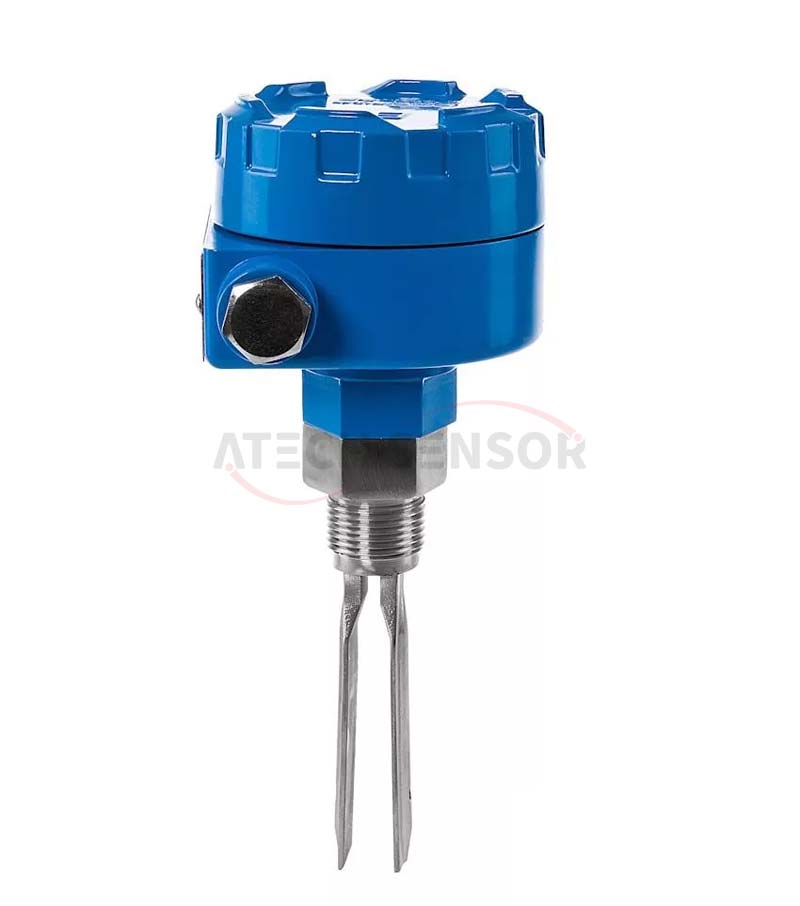
Principle:
The tuning fork level controller is a new type of level switch. It is designed and manufactured based on the principle of tuning fork vibration. It is at the base of the sensing rod of the tuning fork level switch, driving the tuning fork rod through a piezoelectric chip, and receiving the vibration signal by another piezoelectric chip, so that the vibration signal can be circulated and the sensing rod can resonate.
When the material contacts the sensing rod, the vibration signal gradually decreases until the resonance stops, and the control circuit will output an electrical contact signal. Due to the natural principle that the sensitivity of the sensing rod decreases from the front to the back seat, when the material in the tank and the surrounding of the barrel accumulate upward, touch the base of the sensing rod (the back) or discharge the material, no error signal will be generated.
In short, the tuning fork generates mechanical vibration under the excitation of the piezoelectric crystal, and this vibration has a certain frequency and amplitude. When the tuning fork is immersed in liquid or solid, the vibration frequency and amplitude of the tuning fork will change. This frequency change is detected by the electronic circuit and a switch quantity is output.
Scope of application and features:
The tuning fork level switch is a new type of level switch. It is suitable for almost all liquid media, and is also suitable for measuring medium-density solid powders or particles that can flow freely. Since the tuning fork level switch has basically no moving parts and has relatively low mechanical wear, it does not require maintenance and adjustment, and is simple and convenient to use.

